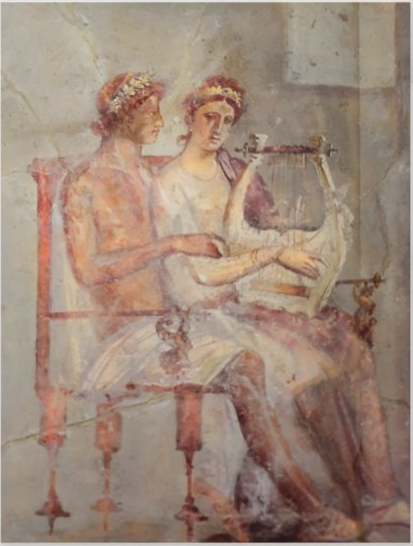This fresco, found in Pompeii, an ancient Roman city, is an impressive artwork not only for its historical value but also for the story of love and music it conveys. Initially, this panel was interpreted as depicting a music lesson, but over time and with deeper research, it has been identified as a scene of love, offering us a glimpse into the connection between music and emotions in ancient Roman society.
Table of Contents
ToggleThe Panel: A Scene of Love in an Intimate Space
The fresco portrays a woman playing the kithara, a stringed instrument similar to a harp, which was popular in both Greek and Roman cultures. She sits in a domestic setting, where a sense of intimacy and warmth is evident. Classic in many works of art from this period, the scene is not just about music; it also represents a moment of affection, where music serves as a bridge between two people.
The man in the panel sits next to the woman, his gaze filled with admiration and love, a clear expression of romantic affection. This gesture reflects not only the relationship between them but also highlights an important aspect of Roman society: relationships between men and women were often expressed through subtle actions and the arts, rather than solely through words.

The Kithara: Music as the Language of Love
The kithara was not just an instrument but a symbol of culture and sophistication in Roman society. Considered one of the principal instruments in religious ceremonies and social events, the kithara was also linked to romantic moments. The act of the woman playing the kithara can be understood as an expression of her talent, but it also reflects the connection between music and affection.
In Roman culture, music was not just entertainment; it was a part of spiritual and cultural life. Women who played instruments like the kithara were often regarded as educated and refined, as they participated in social activities while also displaying their artistic abilities. When coupled with love, music became a language of emotion, making relationships deeper and more meaningful.

Pompeii: A City Forever Marked in History
Pompeii, the location where this panel was discovered, holds a unique historical significance. Buried under layers of volcanic ash from the eruption of Mount Vesuvius in 79 CE, Pompeii has been preserved almost perfectly for nearly 2,000 years. This not only allows us to access the artifacts and art of a lost civilization but also offers insight into the lives of the city’s inhabitants. Artworks like this provide a realistic view of social relationships, interests, and customs in ancient Roman society.
Love, Music, and Roman Society
This fresco is not just an artwork about love and music; it also reflects the sophistication of social relationships in Roman society. Music, especially when played in the private space of the home, was an important means of expressing emotions and connecting individuals. The scene of the woman playing the kithara for her lover reveals how music was an essential part of romantic relationships. In Roman society, where family and personal relationships were highly valued, sharing such intimate moments served as evidence of deep affection and bond.
The fresco not only evokes a gentle moment of love but also highlights the appreciation for art and music in Roman life. This scene demonstrates a strong connection between personal emotions and refined forms of art, reflecting the rich and complex life of the Romans in the first century CE.
